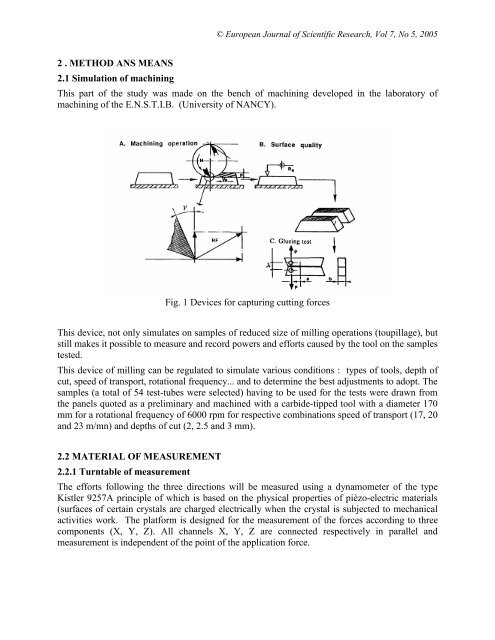European Journal of Scientific Research (ISSN: 1450 ... - EuroJournals
European Journal of Scientific Research (ISSN: 1450 ... - EuroJournals
European Journal of Scientific Research (ISSN: 1450 ... - EuroJournals
Create successful ePaper yourself
Turn your PDF publications into a flip-book with our unique Google optimized e-Paper software.
© <strong>European</strong> <strong>Journal</strong> <strong>of</strong> <strong>Scientific</strong> <strong>Research</strong>, Vol 7, No 5, 2005<br />
2 . METHOD ANS MEANS<br />
2.1 Simulation <strong>of</strong> machining<br />
This part <strong>of</strong> the study was made on the bench <strong>of</strong> machining developed in the laboratory <strong>of</strong><br />
machining <strong>of</strong> the E.N.S.T.I.B. (University <strong>of</strong> NANCY).<br />
Fig. 1 Devices for capturing cutting forces<br />
This device, not only simulates on samples <strong>of</strong> reduced size <strong>of</strong> milling operations (toupillage), but<br />
still makes it possible to measure and record powers and efforts caused by the tool on the samples<br />
tested.<br />
This device <strong>of</strong> milling can be regulated to simulate various conditions : types <strong>of</strong> tools, depth <strong>of</strong><br />
cut, speed <strong>of</strong> transport, rotational frequency... and to determine the best adjustments to adopt. The<br />
samples (a total <strong>of</strong> 54 test-tubes were selected) having to be used for the tests were drawn from<br />
the panels quoted as a preliminary and machined with a carbide-tipped tool with a diameter 170<br />
mm for a rotational frequency <strong>of</strong> 6000 rpm for respective combinations speed <strong>of</strong> transport (17, 20<br />
and 23 m/mn) and depths <strong>of</strong> cut (2, 2.5 and 3 mm).<br />
2.2 MATERIAL OF MEASUREMENT<br />
2.2.1 Turntable <strong>of</strong> measurement<br />
The efforts following the three directions will be measured using a dynamometer <strong>of</strong> the type<br />
Kistler 9257A principle <strong>of</strong> which is based on the physical properties <strong>of</strong> pièzo-electric materials<br />
(surfaces <strong>of</strong> certain crystals are charged electrically when the crystal is subjected to mechanical<br />
activities work. The platform is designed for the measurement <strong>of</strong> the forces according to three<br />
components (X, Y, Z). All channels X, Y, Z are connected respectively in parallel and<br />
measurement is independent <strong>of</strong> the point <strong>of</strong> the application force.

















